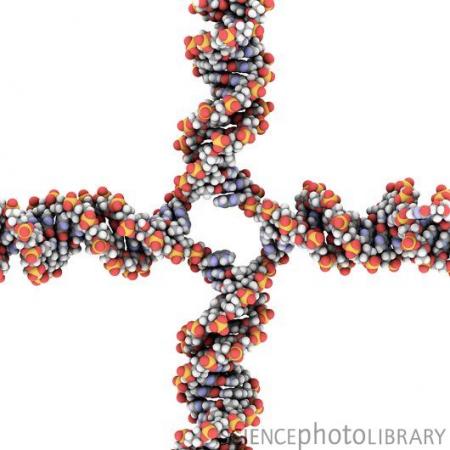来自浙江大学生命科学研究院,美国M.D.安德森癌症中心的研究人员发现了人体细胞中一种重要蛋白复合物的关键作用,并证明了这种蛋白的进化保守性,这将有助于深入了解该蛋白特性,以及DNA修复过程。这一研究成果公布在JBC杂志上。
这项研究由浙江大学生命科学研究院与美国M.D.安德森癌症中心合作完成,浙江大学生命科学研究院的刘婷博士和硕士研究生万力是这篇文章的共同第一作者。
电离辐射等都会造成机体DNA损伤,如果不进行修复则可能导致染色体断裂和细胞死亡,而修复不当则可能导致染色体缺失、重排、转位和倒置等,从而易于形成肿瘤等疾病。DNA同源重组修复(homologous recombination repair,HRR)是DNA损伤修复的主要方式之一,对于保持哺乳动物细胞的基因组完整性十分重要。

Shu蛋白复合物参与DNA同源重组
酵母细胞DNA同源重组修复过程中有一种重要的功能元件:Shu蛋白复合物,但是对于人体细胞中Shu蛋白复合物是如何组成以及Shu蛋白复合物的功能,目前科学家们还却并不清楚。
在这篇文章中,研究人员通过生化纯化方法克隆了一个新的蛋白SWSAP1/C19orf39,并发现SWSAP1能够与hSWS1组成人的细胞中的Shu蛋白复合物。实验发现该蛋白复合物具有单链DNA结合活性以及ATP酶活性,在细胞内降低SWSAP1的表达会减弱人的细胞的同源重组能力。这一研究结果表明Shu蛋白复合物在进化的过程中具有高度的保守性。
这一研究组致力于DNA损伤修复研究,曾于去年在Science上发文,发现了这一被DNA损伤修复领域研究者们期待已久的关键蛋白的功能和机制,获得了DNA损伤修复领域的重大发现。
研究表明,被命名为 FAN1(Fanconi anemia-associated nuclease 1)的蛋白同时具有泛素结合活性的锌指结构域以及核酸酶内切酶结构域,通过与泛素分子的直接相互作用,FAN1被活化的ID复合体招募到DNA交联损伤位点,并通过其内切核酸酶的活性对损伤位点进行剪切,从而得到适合重组修复的DNA底物。
相关英文论文摘要:
hSWS1-SWSAP1 is an evolutionarily conserved complex required for efficient homologous recombination repair
The Shu complex in yeast plays an important role in homologous recombination pathway, which is critical for the maintenance of genomic integrity. The identification of human SWS1 (hSWS1) as the homologue of budding yeast Shu2 implicated that the Shu complex is evolutionarily conserved. However, the human counterparts of other components in this complex have not yet been identified and characterized. Here we describe the characterization of a novel human component of this complex, SWSAP1 (hSWS1-associated protein 1) /C19orf39. We show that hSWS1 and SWSAP1 form a stable complex in vivo and in vitro. hSWS1 and SWSAP1 are mutually interdependent for their stability. We further demonstrate that the purified hSWS1-SWSAP1 complex possesses single-stranded DNA binding activity and DNA-stimulated ATPase activity. Moreover, SWSAP1 interacts with RAD51 and RAD51 paralogs and depletion of SWSAP1 causes defects in homologous recombination repair. Thus, our results suggest that the human Shu complex (hSWS1-SWSAP1) has an evolutionarily conserved function in homologous recombination.







